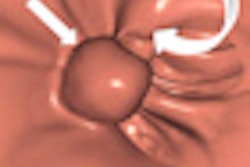
CAMBRIDGE, MA - Virtual colonoscopy screening advocates were upbeat about their quest for reimbursement of the exam at this week's 2011 International Symposium on Virtual Colonoscopy. Which is not to say that getting doctors paid to perform virtual colonoscopy has been an easy struggle, or a particularly quick one.
In May 2009, the U.S. Centers for Medicare and Medicaid Services (CMS) denied a request for Medicare reimbursement of VC (also known as CT colonography or CTC), citing three principal areas that needed more research. Since then, VC proponents have worked to satisfy the concerns expressed by CMS, including those about radiation dose, extracolonic findings, and VC results in Medicare-aged populations.
"I think we're in a much better position than we were at this time last year," said Dr. Judy Yee, professor and vice chair of radiology at the University of California, San Francisco, and a member of the American College of Radiology's (ACR) Colon Cancer Committee.
After all, Yee noted in her October 24 presentation, since the 2009 coverage denial, key studies have been published demonstrating that radiation doses are low, extracolonic findings are easily managed, and VC in older Medicare populations is just as effective as it is in folks just turning 50.
Unveiled in 1994, CTC's noninvasive whole-colon screening test years ago proved its efficacy in detecting clinically significant colorectal polyps more safely than its chief competitor, optical colonoscopy.
But payment by Medicare and private insurance carriers at levels that would usher in routine clinical use hasn't proved easy. And since the CMS denial in 2009, the industry has run into headwinds that are less about screening than about the state of the U.S. in general.
Tough environment
"It's been a perfect storm of healthcare reform, [U.S.] financial problems, politics, and concerns about radiation," Yee said.
Never mind that the radiation doses involved in VC have been shown to be small -- as low as 3 mSv to 6 mSv per exam -- and rapidly diminishing, or that optical colonoscopy has been estimated to kill at least 300 Americans a year due to colonic perforation, versus no deaths with CTC (which, to be fair, detects but does not remove polyps).
Participants invited to this year's unusual non-continuing medical education (CME) session at the symposium cited a litany of concerns about payment roadblocks ahead, ranging from efforts to trim radiology spending in general to bias against CT exams in particular. There is even a gnawing sense that Congress in its current mood seems unwilling to do anything that might add to healthcare costs in the short-term, no matter how beneficial the effect on patients or the bottom line in the long-term, as colon cancers might be prevented in great numbers with more screening now.
It's a struggle that VC advocates aim to win, but it doesn't help that colorectal cancer is "still a taboo subject" that lacks the political power of breast cancer advocacy or even the emotional pull of heart attack prevention, according to Dr. Michael Zalis, director of CTC at Massachusetts General Hospital.
Today's battle, according to participants in the two-day symposium, is more about winning the hearts and minds of patients, practitioners, politicians, and medical societies than it is a debate about the merits of including CTC as a colorectal cancer screening option.
Meeting challenges with evidence
For this goal, the ACR's Colon Cancer Committee has a plan that is proceeding on schedule and is undergoing continuous refinement, participants said.
CMS' concerns about radiation, extracolonic findings, and older patients were actually fairly limited, Yee said, and the recent clinical studies have answered them sufficiently, with more to come. As far as CMS and the U.S. Preventive Services Task Force (USPSTF) are concerned, "what they want is what we have," Yee said.
For example, investigators Hassan et al, Berland et al, and Macari et al examined extracolonic findings in clinical CTC practice, and found them to be not too expensive or frequent. Studies by Knudsen et al and Kim et al and a definitive paper to be published in early 2012 will also put to rest any concerns that VC might be less effective in Medicare-aged populations, Yee said.
Radiation concerns have been addressed by Leidenbaum et al, Flicek et al, and Berrington de González et al, to name a few.
In their recent American Journal of Roentgenology paper, for example, de González and colleagues looked at the benefit-risk ratio of cancers prevented or induced by CTC, Yee said. Applying the ACR Imaging Network's CTC protocol to the 2006 Biological Effects of Ionizing Radiation (BEIR) VII radiation report and three independent microsimulation models, the authors estimated radiation-induced cancers from CTC screening every five years at 150 per 100,000 -- versus 5,190 colon cancers prevented by CTC screening in every 100,000 patients.
And that number "included the radiation risk from extra imaging for extracolonic findings," Yee said, making a compelling case that CTC produces benefits that "clearly outweigh radiation risks."
In their study, Hassan and colleagues found that adding a single extra exam using CTC data -- in this case, screening for abdominal aortic aneurysm (AAA) -- rendered virtual colonoscopy cost-effective even under the difficult criteria of the simulation models used by CMS.
In terms of virtual colonoscopy's effectiveness in Medicare beneficiaries, Macari and colleagues found no significant differences in the percentage of nonseniors (mean age, 52 years) versus seniors (mean age, 69 years) who had polyps 6 mm or larger (14.2% versus 13.2%), nor in the percentage of patients with a polyp 1 mm or larger (4.4% versus 6.0%).
There was a barely significant difference in the percentage of patients needing extra imaging as a result of CTC (4.4% of nonseniors versus 6% of seniors [p = 0.045]), but the number of additional scans remained quite low for all patients, Yee said.
New ideas to promote VC's value
Several symposium participants suggested that any number of exams that can be performed as add-ons using CTC data or perhaps additional anatomic coverage from lung cancer screens -- from bone-mineral densitometry to AAA screening to coronary calcium scores -- could definitively distinguish VC from other screening methods, while boosting its value in detecting any number of common but deadly pathologies.
Of course, doing anything in a package deal would technically be committing Medicare fraud by underbilling under current rules; avoiding it would require a fundamental Medicare rule change "that would end up upsetting a lot of people," noted Dr. Mark Klein of Washington Radiology Associates in Washington, DC.
Others suggested the development of a prospective trial to document the high frequency of screening optical colonoscopy exams and expensive biopsies that occur in routine clinical practice. Together, these practices boost the real cost of conventional colonoscopy far higher than is accounted for in simulation models used to gauge cost-effectiveness, they said.
CTC is being used with increasing frequency for colon cancer staging and surgery planning, and it may be equivalent to MRI for this purpose, said Dr. David Kim from the University of Wisconsin.
Other steps
Yee noted another small victory in the 2010 achievement of a relative value unit (RVU) increase in diagnostic CTC (to 2.40) before the CMS refinement panel.
On the legislative front, HR 5461, the Virtual Screening for Colorectal Cancer Act, would amend the Social Security Act to cover CTC as a screening test under Medicare. Currently on hold, the bill is expected to be reintroduced in early 2012 as efforts continue to recruit additional sponsors, especially Republicans, Yee said.
On the state level, the ACR packet introduced last year is being beefed up with additional legislative resources. ACR Colon Cancer Committee members continue to work with ACR state chapter leaders, local state CTC advocates, and patient advocates to approach insurance commissioners and private payors, Yee said.
The use of CTC, via American Cancer Society guidelines, is now mandated for some indications in 22 states, but efforts in other states that could progress toward requiring CTC continue to languish for lack of "champions" who are willing to step up and educate local payors and Medicare carriers about the benefits of the exam, Yee said.
State-by-state efforts
Three major carriers in Virginia, Maryland, and Washington, DC, now cover CTC due to efforts spearheaded by Washington Radiology Associates, she said.
Illinois Blue Cross/Blue Shield recently explored adding CTC but decided not to modify its policy at the present time. Wisconsin, known for its liberal CTC coverage policies, allows individual carriers to determine which screening guidelines to follow. The next states in the push for payor acceptance of CTC will be Arizona, California, Georgia, Massachusetts, and New York, Yee said.
The ACR committee continues to work with payors to encourage coverage and the drafting of policies reflecting its preferred CTC model. The next push for a new review of Medicare coverage by CMS will take place in time for Colon Cancer Awareness month in March 2012, she said. By then, continuing accumulation of new evidence will bolster the case for CTC.
"The timing might actually work out in our favor," Yee said. The idea is that even if the CMS review should come up negative, its comments can be used next year to gather whatever additional information is needed; in any case, by 2013, it will be time for a renewed push for review by another major player, USPSTF. And by then more key evidence will be published, according to Yee.
In response to a question from a symposium participant, Yee acknowledged that CMS could conceivably keep coming up with new reasons to deny coverage even after its original requirements for additional evidence were met. But outcry from patients and other advocates of CTC could make it difficult for them to "keep raising the bar," she said.




















